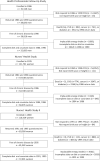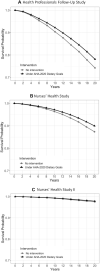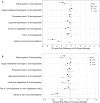Estimating the effect of nutritional interventions using observational data: the American Heart Association's 2020 Dietary Goals and mortality
- PMID: 34041538
- PMCID: PMC8326054
- DOI: 10.1093/ajcn/nqab100
Estimating the effect of nutritional interventions using observational data: the American Heart Association's 2020 Dietary Goals and mortality
Abstract
Background: Because randomized trials of sustained dietary changes are sometimes impractical for long-term outcomes, the explicit emulation of a (hypothetical) target trial using observational data may be an important tool for nutritional epidemiology.
Objectives: We describe a methodological approach that aims to emulate a target trial of dietary interventions sustained over many years using data from observational cohort studies.
Methods: We estimated the 20-y risk of all-cause mortality under the sustained implementation of the food-based goals of the American Heart Association (AHA) 2020 using data from 3 prospective observational studies of US men [Health Professionals Follow-up Study (HPFS)] and women [Nurses' Health Study (NHS) and Nurses' Health Study II (NHS II)]. We applied the parametric g-formula to estimate the 20-y mortality risk under a dietary intervention and under no dietary intervention.
Results: There were 165,411 participants who met the eligibility criteria. The mean age at baseline was 57.4 y (range, 43-82 y) in the HPFS, 52.4 y (range, 39-66 y) in the NHS, and 40.2 y (range, 30-50 y) in the NHS II. During 20 y of follow-up, 13,241 participants died. The estimated 20-y mortality risks under a dietary intervention versus no intervention were 21.9% compared with 25.8%, respectively, in the HPFS (risk difference, -3.9%; 95% CI: -4.9% to -3.2%); 10.0% compared with 12.6%, respectively, in the NHS (risk difference, -2.6%; 95% CI: -3.1% to -1.8%); and 2.1% compared with 2.5%, respectively, in the NHS II (risk difference, -0.35%; 95% CI: -0.56% to -0.09%). The corresponding risk ratios were 0.85 (95% CI: 0.81-0.88) in the HPFS, 0.79 (95% CI: 0.75-0.85) in the NHS, and 0.86 (95% CI: 0.78-0.96) in the NHS II.
Conclusions: We estimated that adherence to the food-based AHA 2020 Dietary Goals starting in midlife may reduce the 20-y risk of mortality.
Keywords: American Heart Association 2020 Dietary Goals; g-formula; mortality; nutritional epidemiology; target trial.
© The Author(s) 2021. Published by Oxford University Press on behalf of the American Society for Nutrition.
Figures




Comment in
-
What would the trial be? Emulating randomized dietary intervention trials to estimate causal effects with observational data.Am J Clin Nutr. 2021 Aug 2;114(2):416-417. doi: 10.1093/ajcn/nqab169. Am J Clin Nutr. 2021. PMID: 34041528 No abstract available.
Similar articles
-
Intakes of Unprocessed and Minimally Processed and Ultraprocessed Food Are Associated with Diet Quality in Female and Male Health Professionals in the United States: A Prospective Analysis.J Acad Nutr Diet. 2023 Aug;123(8):1140-1151.e2. doi: 10.1016/j.jand.2023.03.011. Epub 2023 Mar 24. J Acad Nutr Diet. 2023. PMID: 36965524
-
Long-Term Change in Diet Quality Is Associated with Body Weight Change in Men and Women.J Nutr. 2015 Aug;145(8):1850-6. doi: 10.3945/jn.114.208785. Epub 2015 Jun 17. J Nutr. 2015. PMID: 26084363 Free PMC article.
-
Estimating the Effect of Adhering to the Recommendations of the 2019 Canada's Food Guide on Health Outcomes in Older Adults: Protocol for a Target Trial Emulation.JMIR Res Protoc. 2025 Jan 23;14:e65182. doi: 10.2196/65182. JMIR Res Protoc. 2025. PMID: 39847422 Free PMC article.
-
Dietary interventions for adult cancer survivors.Cochrane Database Syst Rev. 2019 Nov 22;2019(11):CD011287. doi: 10.1002/14651858.CD011287.pub2. Cochrane Database Syst Rev. 2019. PMID: 31755089 Free PMC article.
-
Nutritional epidemiology and the Women's Health Initiative: a review.Am J Clin Nutr. 2021 May 8;113(5):1083-1092. doi: 10.1093/ajcn/nqab091. Am J Clin Nutr. 2021. PMID: 33876183 Free PMC article. Review.
Cited by
-
Hypothetical 22-Year Intervention With the Dietary Approaches to Stop Hypertension and Risk of Heart Failure in a General Population.Am J Epidemiol. 2024 Jan 8;193(1):96-106. doi: 10.1093/aje/kwad181. Am J Epidemiol. 2024. PMID: 37656615 Free PMC article.
-
Adherence to the EAT-Lancet diet in midlife and development in weight or waist circumference after five years in a Danish cohort.Dialogues Health. 2023 Aug 19;3:100151. doi: 10.1016/j.dialog.2023.100151. eCollection 2023 Dec. Dialogues Health. 2023. PMID: 38515808 Free PMC article.
-
Overnight Fasting and Body Weight: Emulated Target Trial Using Cancer Prevention Study-3 Data.Nutrients. 2025 Apr 30;17(9):1559. doi: 10.3390/nu17091559. Nutrients. 2025. PMID: 40362868 Free PMC article.
-
Impact of lowering fine particulate matter from major emission sources on mortality in Canada: A nationwide causal analysis.Proc Natl Acad Sci U S A. 2022 Dec 6;119(49):e2209490119. doi: 10.1073/pnas.2209490119. Epub 2022 Nov 28. Proc Natl Acad Sci U S A. 2022. PMID: 36442082 Free PMC article.
-
Association of ultra-processed food consumption with colorectal cancer risk among men and women: results from three prospective US cohort studies.BMJ. 2022 Aug 31;378:e068921. doi: 10.1136/bmj-2021-068921. BMJ. 2022. PMID: 38752573 Free PMC article.
References
-
- Estruch R, Ros E, Salas-Salvado J, Covas MI, Corella D, Aros F, Gomez-Gracia E, Ruiz-Gutierrez V, Fiol M, Lapetra Jet al. . Primary prevention of cardiovascular disease with a Mediterranean diet supplemented with extra-virgin olive oil or nuts. N Engl J Med. 2018;378(25):e34. doi:10.1056/NEJMoa1800389. - PubMed
-
- de Lorgeril M, Salen P, Martin JL, Monjaud I, Delaye J, Mamelle N. Mediterranean diet, traditional risk factors, and the rate of cardiovascular complications after myocardial infarction: final report of the Lyon Diet Heart Study. Circulation. 1999;99(6):779–85. - PubMed
-
- Esposito K, Marfella R, Ciotola M, Di Palo C, Giugliano F, Giugliano G, D'Armiento M, D'Andrea F, Giugliano D. Effect of a Mediterranean-style diet on endothelial dysfunction and markers of vascular inflammation in the metabolic syndrome: a randomized trial. JAMA. 2004;292(12):1440–6. - PubMed
-
- Shai I, Schwarzfuchs D, Henkin Y, Shahar DR, Witkow S, Greenberg I, Golan R, Fraser D, Bolotin A, Vardi Het al. . Weight loss with a low-carbohydrate, Mediterranean, or low-fat diet. N Engl J Med. 2008;359(3):229–41. - PubMed
-
- Appel LJ, Moore TJ, Obarzanek E, Vollmer WM, Svetkey LP, Sacks FM, Bray GA, Vogt TM, Cutler JA, Windhauser MMet al. . A clinical trial of the effects of dietary patterns on blood pressure. DASH Collaborative Research Group. N Engl J Med. 1997;336(16):1117–24. - PubMed
Publication types
MeSH terms
Grants and funding
LinkOut - more resources
Full Text Sources
Other Literature Sources
Medical
Miscellaneous

